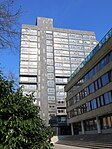Royal Hospital for Sick Children, Edinburgh
1860 establishments in ScotlandCategory B listed buildings in EdinburghChildhood in ScotlandChildren's hospitals in the United KingdomDefunct hospitals in Scotland ... and 7 more
Hospital buildings completed in 1863Hospitals established in 1860Hospitals in EdinburghListed hospital buildings in ScotlandNHS LothianOrganisations based in Edinburgh with royal patronageUse British English from July 2015

The Royal Hospital for Sick Children was a hospital in Edinburgh, Scotland, specialising in paediatric healthcare. Locally, it was commonly referred to simply as the Sick Kids. The hospital provided emergency care for children from birth to their 13th birthday, including a specialist Accident and Emergency facility. Some in-patient specialties saw children up to their 16th birthday. The hospital was located on Sciennes Road in the Sciennes area of Edinburgh's South Side and was managed by NHS Lothian. It closed in 2021, to be replaced by new children’s health facilities in the nearby Royal Infirmary.
Excerpt from the Wikipedia article Royal Hospital for Sick Children, Edinburgh (License: CC BY-SA 3.0, Authors, Images).Royal Hospital for Sick Children, Edinburgh
Sciennes Road, City of Edinburgh The Grange
Geographical coordinates (GPS) Address External links Nearby Places Show on map
Geographical coordinates (GPS)
| Latitude | Longitude |
|---|---|
| N 55.938333333333 ° | E -3.1888888888889 ° |
Address
Sciennes Road
EH9 1TP City of Edinburgh, The Grange
Scotland, United Kingdom
Open on Google Maps









